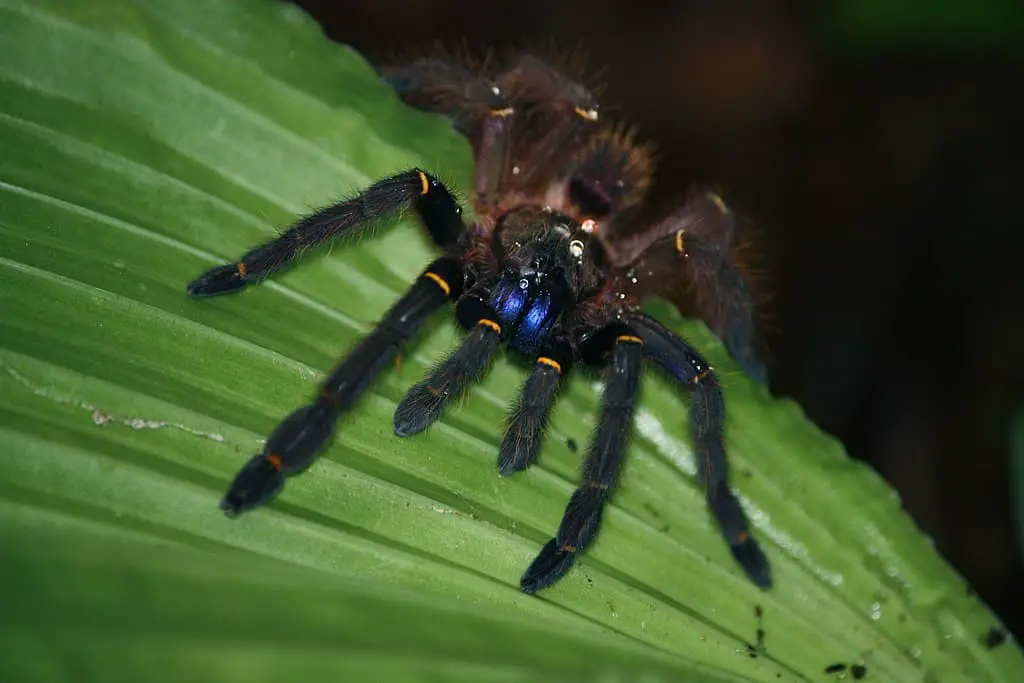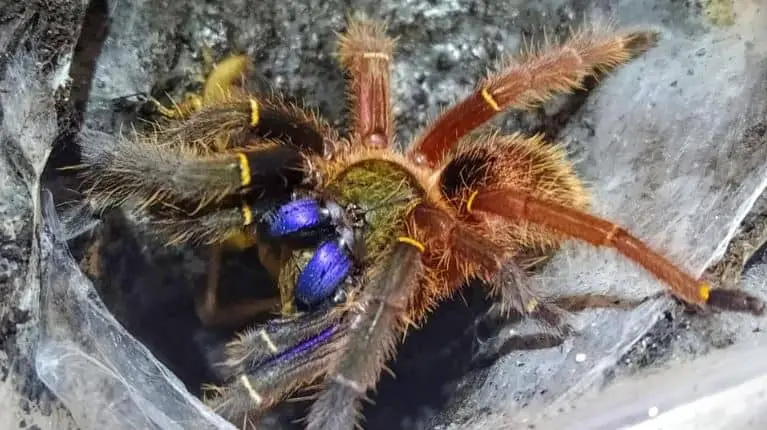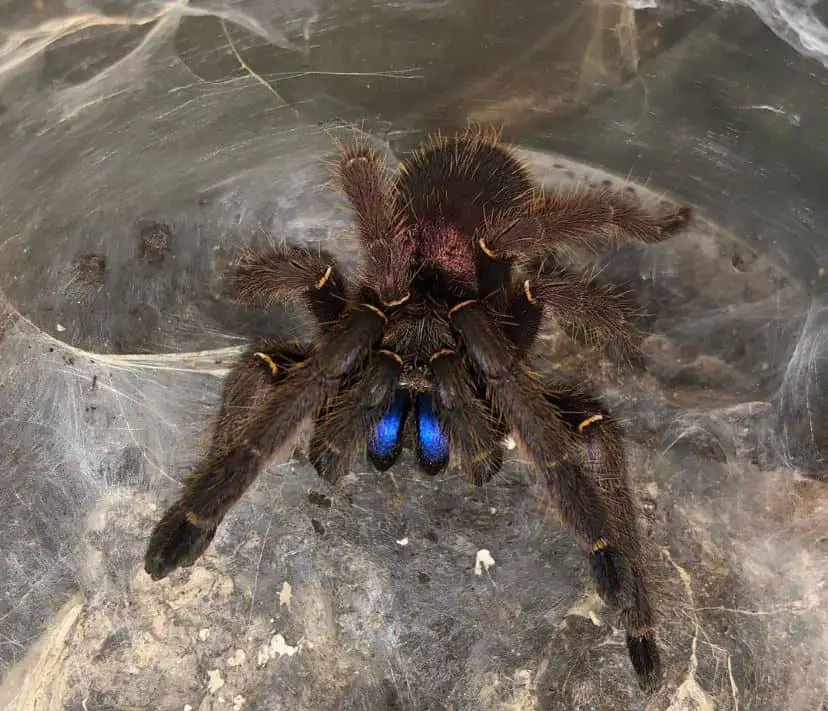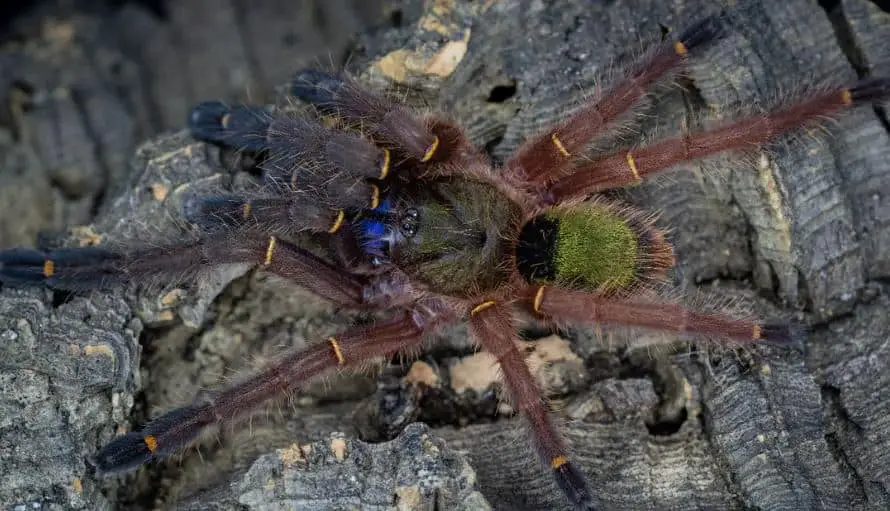The Blue Fang tarantula (Ephebopus cyanognathus), is a New World terrestrial tarantula known for its blue fangs and beautifully colored carapace. This species is native to French Guyana where it lives on the forest floors.
It’s quite a defensive spider, which can make it quite tricky to handle. However, if you’ve got some experience handling tarantulas this beauty can be a great addition to any collection. To learn everything you need to know about this magnificent species, keep reading.

Blue Fang Tarantula Care Sheet
| Species Name | Ephebopus cyanognathus |
| Family Name | Theraphosidae |
| Common Name | Blue Fang Tarantula, Blue Fang Skeleton |
| Category | New World |
| Type | Terrestrial |
| Native Location | French Guyana |
| Body Length | 1.5 to 2 inches |
| Leg Span | 4.5 to 5 inches |
| Growth Speed | Fast |
| Urticating Hairs | Yes |
| Social | Solitary |
| Diet | Insects: crickets, roaches, mealworms, etc |
| Temperature | 75 to 80 Fahrenheit |
| Humidity | 75 to 80% |
| Life Expectancy | Females, 12 to 15 years. Males, 3 to 4 years. |
| Recommended Experience Level | Intermediate/advanced |
| Minimum tank size | 12″x12″x16″ |
Blue Fang Tarantula Overview

The Blue Fang tarantula is a spider native to French Guyana. It was first described in the year 2000 when it was found in the Chevaux mountains.
It’s most well known for its blue venomous fangs which give the species a uniquely colored appearance. They’re a New World terrestrial species with a tendency to burrow. In the wild, they create their burrows about 12 inches underground.
Although the species is mainly terrestrial, they do also dare to climb sometimes, especially the slings.
Appearance & Varieties

As the name suggests, the Blue Fang tarantula is most well-known for its blue fangs. However, the rest of the spider should not be overlooked. They have a beautiful color palette that can consist of yellow, black, green, and orange. In addition, they have interesting orange rings on their legs. Especially the slings are incredibly beautiful in their appearance.
The spiderlings start out with a bright-colored abdomen that is metallic bright green. As they molt and grow, their color changes.
An interesting thing about this species is that males are quite different from females. As is common in tarantula species, females are larger than males. However, there is another difference. Fully grown female Blue Fangs have fangs that are blue in color whereas those of males are more pink/purple in color.
Blue Fang Tarantula price
The Blue Fang Tarantula is an expensive species. The price depends on whether you buy a male or a female and the age of the spider. Males are cheaper than females due to their shorter lifespan and younger specimens are cheaper than adults because adults are easier to care for.
Expect to pay around $200 for an unsexed juvenile and upwards of $1000 for a female adult.
Behavior & Temperament
The Blue Fang Tarantula is known for its nervous and defensive behavior. Whereas some other species prefer to run from danger, the Blue Fang tends to stand its ground and take on a threat posture.
They’re also quick to throw their urticating hairs which can be quite damaging if they end up in your eyes.
If the urticating hairs are not enough to deter the threat they will use their venomous fangs. As is the case with most New World species, their venom is not particularly strong but still not something you’d want to experience.
The Blue Fang is quite fast, so be extra cautious when interacting with them. Handling is not something that is recommended due to the nature of this tarantula.
While this spider is beautiful to look at, they spend a large portion of their time hidden away in their burrows. This is their natural behavior but does sometimes make it difficult to observe them. As a result, they’re not great as a display species.
How to care for a Blue Fang Tarantula
Tank
A fully grown Blue Fang tarantula needs a tank that’s about 12 inches wide, 12 inches long, and 16 inches high. A bigger enclosure is possible, but not necessary.
Tarantulas are sedentary animals that do not enjoy walking around too much. They prefer to sit in place and expend as little energy as possible so a big terrarium does not benefit them very much.
Temperature & humidity
When housing a captive tarantula it’s always a good idea to closely simulate the temperature and humidity of their native habitat. After all, that’s where they’ve evolved to do well in.
In the case of the Blue Fang, a temperature of 75 to 80 degrees Fahrenheit and a humidity of 75 to 80% are typically good for them as this simulates their natural environment.
To keep the humidity at adequate levels you can mist the enclosure, use proper substrate, and use an oversized water bowl, as the evaporation will increase the moisture in the air.
Ventilation is also important for this species. To increase the ventilation, you can make small holes in the left and right sides of the enclosure so that air can ventilate through it.
Substrate
The Blue Fang tarantula is terrestrial and is an avid borrower, so a thick enough layer of substrate is necessary.
Make sure that they have at least 4 to 6 inches of substrate so that they can create their burrows. Keep in mind that this is a minimum. In the wild, the spider can create burrows as deep as 12 inches underground, so it’s almost impossible to have too thick a layer of substrate.
Materials that you can use for substrate include a mixture of peat moss, sphagnum moss, vermiculite, coconut fiber, and dirt.
Decorations and foliage
The best tank design would be one that closely resembles the forest floors of Guyana. To get an idea of what that looks like, take a look at this video. Good things to add to their enclosure include a piece of cork bark and some fake leaves.
Generally speaking, they don’t need a hide as they will create their own burrow, but feel free to provide them with one.
Social
The Blue Fang Tarantula is not a social species. They live alone and only purposefully meet other tarantulas when it’s time to mate. They can be quite territorial, so make sure that you do not put two of them in the same enclosure.
If communal setups are your thing you should only do so with spiders that have proven that they can live peacefully together. Tarantulas that can do this include the Socotra Blue Baboon and the Trinidad Olive Tarantula.
Molting
Since this species grows quite quickly, it will molt frequently. Molting, the process of shedding its old exoskeleton to make way for a bigger one, is something that every species does. It happens most frequently when they’re young because that’s when they grow the fastest.
When your spider is about to molt it will likely refuse food and water for a few days. Additionally, you should not feed them for a few days after the molt has happened because the fangs need time to harden.
Feeding your Blue Fang Tarantula

The Blue Fang tarantula slings start by eating fruit flies. As they get older, they move on to baby crickets. Once they’re adults they can eat a wide variety of insects such as dubia roaches or crickets.
This species is an avid eater and should be fed about 2 to 3 insects per week. However, no two tarantulas are the same. Different sizes and activity levels mean that every individual needs a different amount of food. If you notice that their abdomen is getting smaller you should feed them more often. If their abdomen is getting too large, tone down the feeding.
Uneaten food should be removed from the enclosure after 24 hours.
Health & Lifespan
This tarantula is generally hardy and healthy. In captivity, not much can threaten it. However, because this species enjoys a humid environment, mites and mold are a common problem for them and something to look out for. Make sure that you have adequate ventilation in their enclosure.
Females of this species typically live for 12 to 15 years, whereas males have a much shorter lifespan at 3 to 4 years.
Blue Fang Tarantula Facts
- The Ephebopus cyanognathus was first described in the year 2000 by Rick C. West and Samuel D Marshall.
- Even though the Ephebopus cyanognathus is mainly fossorial, juveniles of this species have been observed to be semi-arboreal.
- The Blue Fang Tarantula looks quite similar to the Ephebopus uatuman, the difference is mainly in the color of the fangs.
Final words
The Blue Fang tarantula is a species that’s renowned for its beauty and unique appearance. Nevertheless, their defensive and nervous nature does not make them very well suited for newcomers to the hobby. If you’re unfamiliar with raising and handling tarantulas, other species such as the Mexican Red Rump, Greenbottle Blue, or Antilles Pinktoe are better options to consider.
However, if you’ve already got some experience under your belt then the Blue Fang can be an absolute beauty to add to any collection.
- How Long Do American Eskimo Dogs Live? Important Factors and Care Tips - September 29, 2023
- Do American Bulldogs Need Grooming? Essential Tips and Care Guidelines - September 29, 2023
- Do Bengal Cats Enjoy Playing? Essential Tips for Keeping Them Active - September 29, 2023